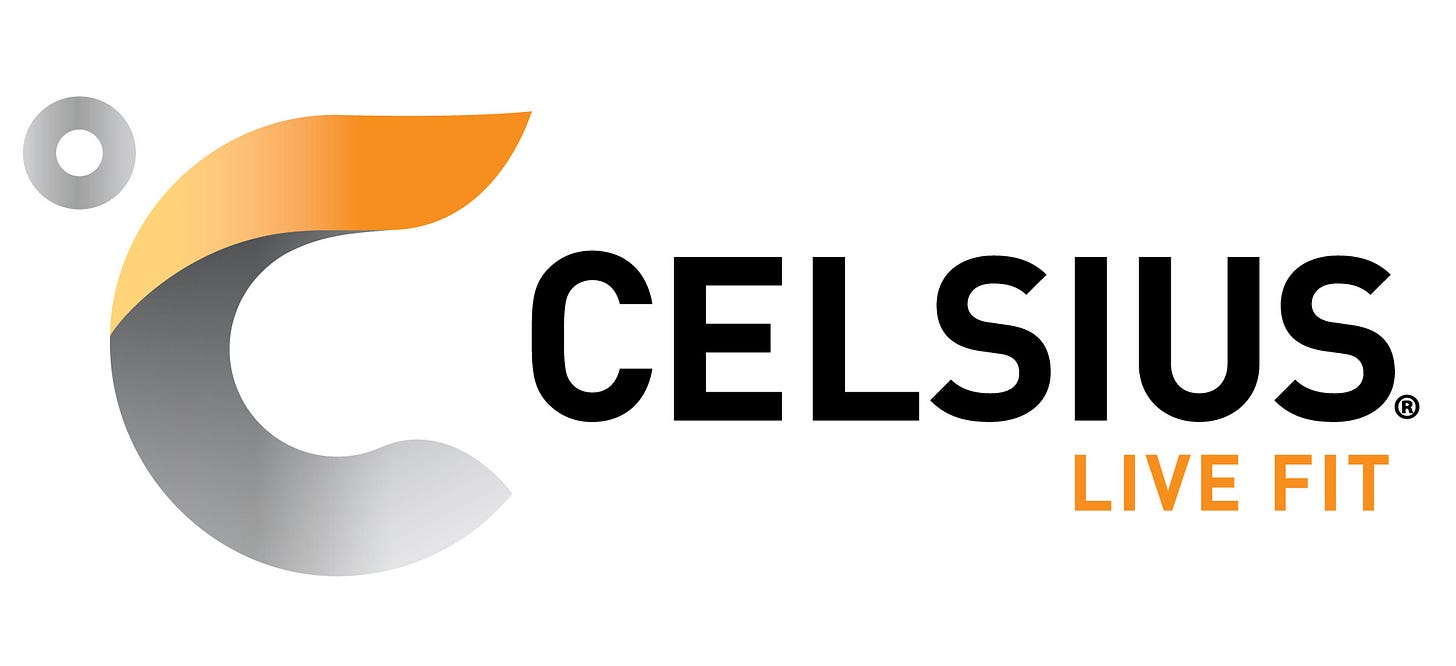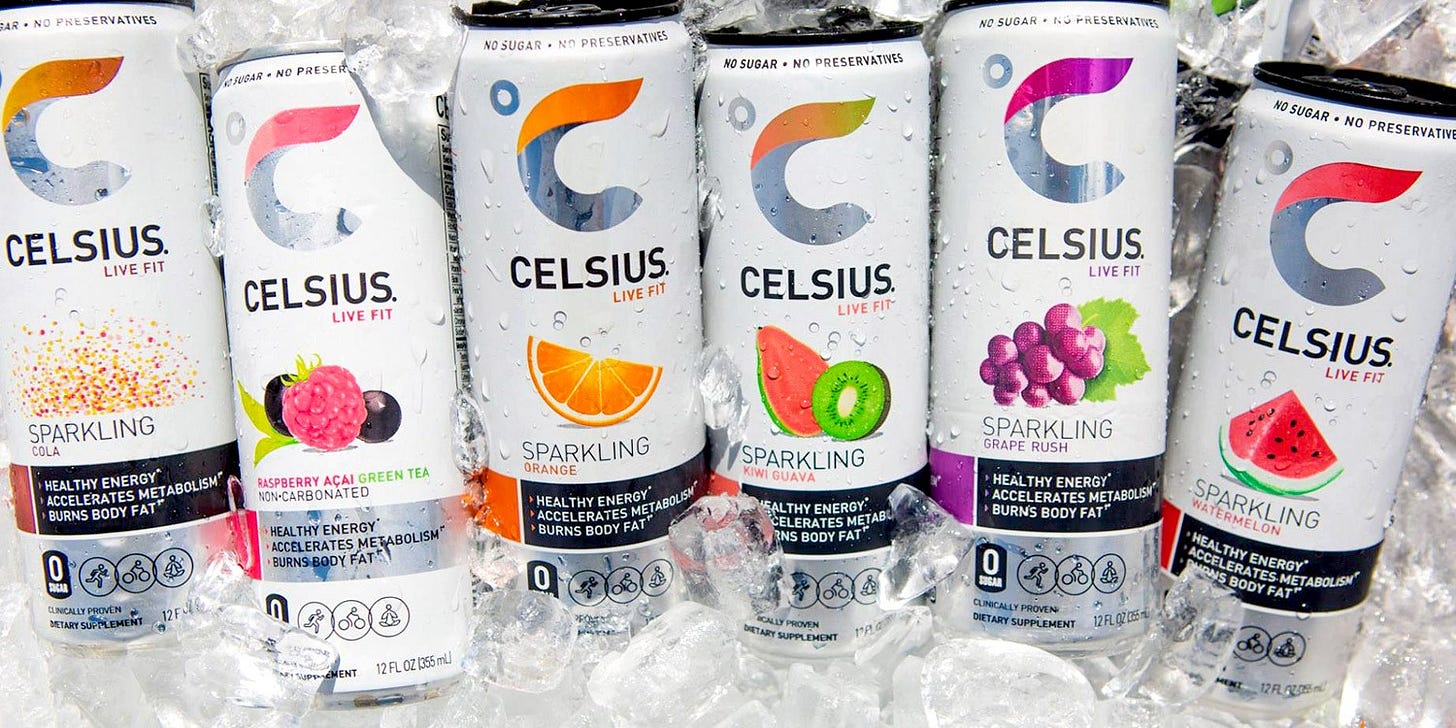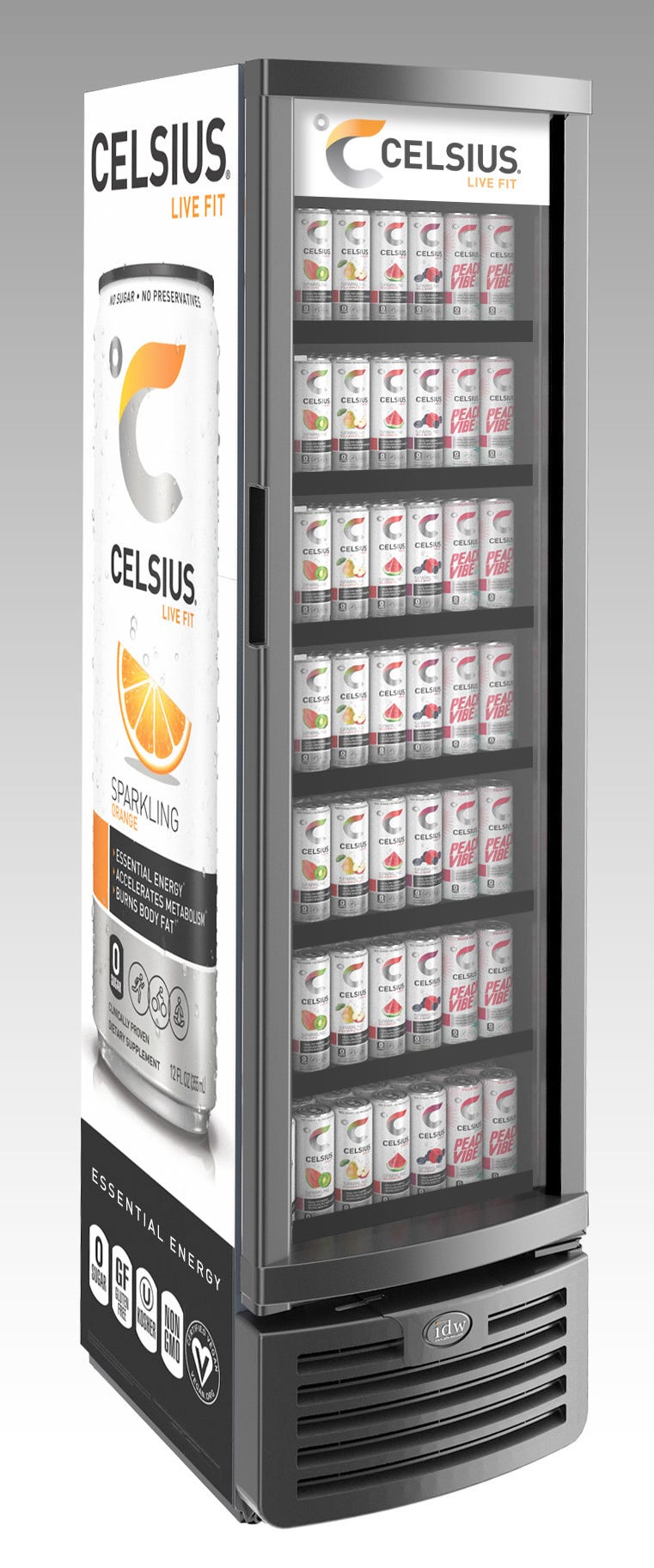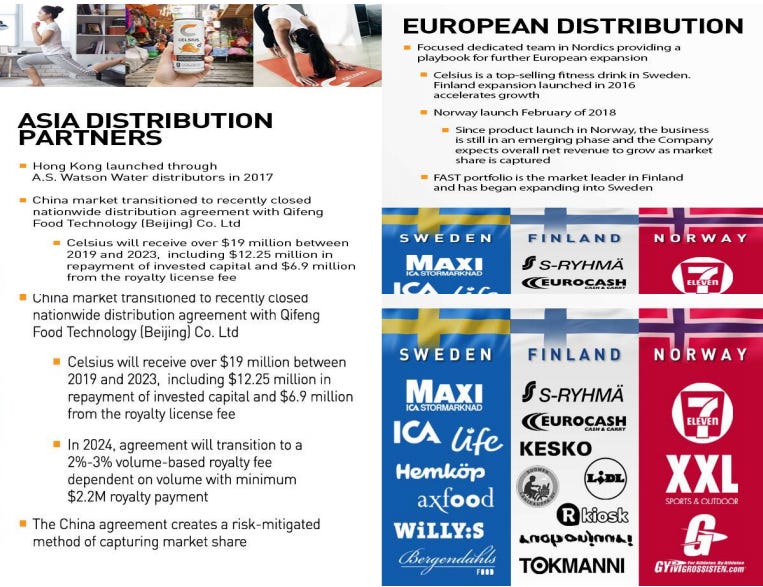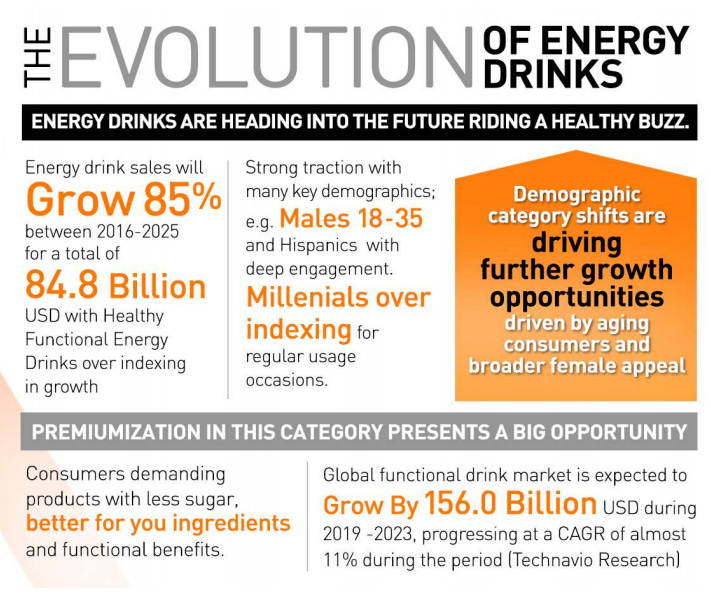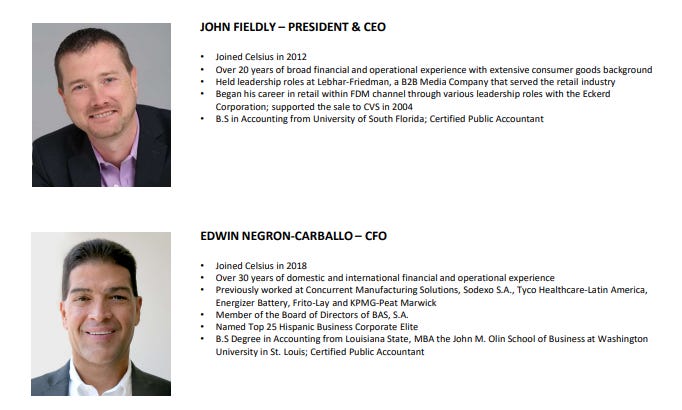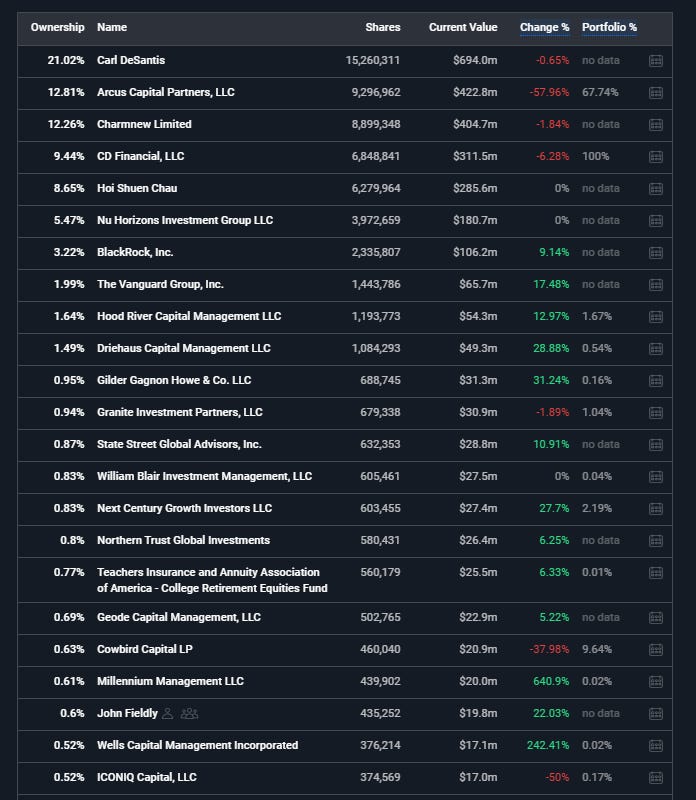CEL 0.00%↑ H - Celsius
Customers: Celsius.com
Investors: CelsiusHoldingsInc.com
Stock Price: $46.00
Market Cap: $3.3 billion
Enterprise Value: $3.25 billion
Headquarters: Boca Raton, FL
Founded: 2004
IPO Date: 2017
CEO: John Fieldly [LinkedIn]
Employees: 160+
Phone: 561-276-2239 or 866-423-5748
Email: celsiuscares@celsius.com
Investor Presentation [click here]
2020 Annual Report, Form 10-K [click here]
Current Report, Form 8-K [click here]
2020 Full Year and Q4 Earnings [click here]
2020 Full Year and Q4 Earnings Call [listen here]
2020 Full Year and Q4 Earnings Call Transcript [read here]
Celsius on Twitter [click here]
Celsius on Facebook [click here]
Celsius on Instagram [click here]
Celsius on LinkedIn [click here]
Celsius on YouTube [click here]
Celsius on Vimeo [click here]
2018 revenues: $52.6 million (actual)
2019 revenues: $75.2 million (actual)
2020 revenues: $130.7 million (actual)
2021 revenues: $178.7 million (estimate) — way too low
2022 revenues: $240.5 million (estimate) — way too low
$CELH - Celsius
Here is my recent interview with John Fieldly, CEO of $CELH [watch here]
INTRODUCTION:
Anyone that follows me on Twitter knows that I’ve been a big fan of $CELH since last summer when I not only started buying the stock at $10-12 per share but I also started drinking their energy drinks. Up until I found $CELH I wasn’t a huge energy drink fan because I knew they were packed with chemicals and artificial ingredients however $CELH is much different which is also why I’m so bullish on the stock/company.
$CELH is a healthier, lighter and more refreshing energy drink which is built around their proprietary “MetaPlus” blend which includes natural ingredients such as guarana extract, green tea leaf extract, ginger root extract, taurine and of course caffeine.
I have encouraged hundreds if not thousands of my friends on Twitter to try $CELH and once they do…they are hooked. $CELH tastes like a higher-quality product and that’s because it is. They don’t pack their products with the artificial junk that you’ll find in their biggest competitors ie Red Bull, Monster, Rockstar and Bang. $CELH is a different breed of energy drinks which is why so many consumers are making the switch.
$CELH has the skinny cans (12 ounces) with 200mg of caffeine per serving.
$CELH also has the bigger cans (16 ounces) with 300mg of caffeine per serving.
Another reason I’m bullish on $CELH is the overall size and growth in the energy drink/beverage market. Based on recent numbers, the global energy drink market has already surpassed $60 billion annually and is growing at 9-10% per year. This means the global energy drink market could reach $100 billion annually within the next 5-6 years.
OVERVIEW:
$CELH develops, markets, distributes, and sells functional calorie-burning fitness beverages in the U.S. and internationally (mostly Europe and Asia). The company offers its beverages in various flavors, including carbonated orange, wild berry, cola, grape, kiwi-guava, and watermelon; and non-carbonated green tea raspberry/acai, green tea/peach mango, green tea/grapefruit melon, pineapple coconut, watermelon berry, and strawberries and cream, as well as sparkling grapefruit, cucumber lime, and orange pomegranate under the Celsius name.
It also provides Celsius Heat, a dietary supplement in carbonated flavors, such as apple jack’d, orangesicle, inferno punch, cherry lime, blueberry pomegranate, strawberry dragonfruit, tangerine grapefruit, and jackfruit. The company distributes its products through direct-store delivery distributors (aka DSD), as well as through retailers including supermarkets, convenience stores, drug stores, nutritional stores, and health clubs, military stores and ecommerce websites.
PRODUCTS:
I have tried 80% of the $CELH and I’m a big fan of almost all of them. My favorites are the carbonated skinny cans (the originals) especially orange, apple pear, watermelon, grape rush and cola. $CELH has done a really nice job with the flavors - they are fruity but not overpowering and not too sweet. I don’t know many people that want to drink a Red Bull or Monster while they are working or doing errands or just living their normal life but this is what $CELH was made for. I’m typically sitting at my desk 90+ hours a week and I usually have a $CELH sitting next to me.
Over the past few years $CELH has done a nice job of expanding their product portfolio because they realize that consumers have different needs and desires when it comes to their beverage choices. Some people can’t handle an energy drink with 300mg of caffeine while others love it. Some people prefer the $CELH powder sticks which are easier for traveling or keeping in your purse.
I’m excited to try the newest addition to the family which are the BCAA drinks. Since I’m a hardcore weightlifter I appreciate the importance of BCAAs for endurance, performance and recovery. BCAAs are the building blocks of proteins and muscle cannot grow without them.
Besides the taste of $CELH drinks, I also appreciate their desire to create something that is healthier — you cannot say this about Monster, Red Bull, Bang or Rockstar. I’m no health expert but based on my research these four products are artificial garbage compared to $CELH and as more consumers realize this they will continue to migrate over to $CELH which will put more pressure on distributors and retailers to dedicate more shelf space to $CELH products.
SCIENCE / DATA:
Celsius is also one of the only energy drink companies to fund multiple clinical studies and based on those results the company can claim “A single serving (12 ounce can) of Celsius® burns 100 to 140 calories by increasing a consumer’s metabolism an average of 12% for up to a three-hour period. In addition, these studies have indicated that drinking a single serving of Celsius® prior to exercising may improve cardiovascular health and fitness and enhance the loss of fat and gain of muscle from exercise.”
$CELH uses no chemical preservatives, aspartame or high fructose corn syrup and uses good-for-you ingredients and supplements such as green tea (EGCG), ginger, calcium, chromium, B vitamins and vitamin C. Celsius is sweetened with sucralose, a sugar-derived sweetener that is found in Splenda®, which makes our beverages low-calorie and suitable for consumers whose sugar intake is restricted. Each 12 ounce can of Celsius® contains 200 milligrams of caffeine which is comparable to one 12-ounce cup of coffee from the leading coffeehouse.
BUSINESS MODEL:
I usually say that $CELH has three main sales channels:
1) fitness - gyms (Gold’s Gym), studios, spas
2) retailers - grocery (Kroger), nutrition (GNC), general merchandise (Target), gas/convenience (Speedway) and drug stores (CVS)
3) ecommerce - Walmart and Amazon
With regards to the first two sales channels listed above, $CELH distributes their products through a hybrid model of direct-store delivery (DSD) and as well as direct to retailers (DTR). $CELH has made it very clear they are focusing on DSD and now have 150+ regional distribution partners on board.
DTR usually means that $CELH is shipping their products to the retailers’ distribution centers, then the stores are ordering product, then it’s being delivered to the store and then it’s sitting in the back room until the employees decide to stock the shelves. This is a very inefficient distribution model with lots of room for mistakes which results in empty shelves. Most brands have to start off with DTR until they are big enough to attract the attention of DSD.
Getting into DSD is a game-changer for $CELH and another reason I’m so bullish on the company. Since many people on Twitter already know my feelings for $CELH they love to send me pictures of their local stores with empty $CELH shelves. This is both good and bad. It’s good because it means that demand is high but it’s bad because it means less sell-through in the stores which means less revenues for $CELH. Pivoting over to DSD might impact net margins but a small amount however the increase in revenues will more than make up for it. With DSD these 150+ regional distribution partners will be responsible for delivering product to the retail stores, stocking the shelves, setting up displays and making sure everything is merchandised and priced correctly. With DSD we won’t have to worry about empty shelves or the $CELH drinks being in the wrong aisle. DSD partners are financially motivated to make sure $CELH is maximizing their sales at every location and these DSD partners would not be taking on $CELH and using up their truck space if they didn’t see huge upside.
I’m also really excited about the new $CELH branded coolers that the company recently announced. On the recent earnings call the CEO said they have already deployed 200+ of these branded coolers into retail locations and some of these stores are already reporting a 200% increase in $CELH sales. These branded coolers are a cost to $CELH however the CEO said the payback on that cost is under 3 months. These coolers will provide a ton of visibility for $CELH plus they are ensuring that customers are getting a cold $CELH rather than a warm one that’s been sitting on a shelf. These $CELH coolers will be perfect for drug stores, gas stations, convenience stores, gyms and major retailers. In addition to the 200+ coolers already deployed, there are another 1,200 on the way.
RETAILERS:
Store locator: https://www.celsius.com/buy-locate
$CELH is currently authorized in more than 82,000 locations and I expect that number to hit 100,000+ in the near future. You can now find $CELH at Walmart, Target, CVS, Vitamin Shoppe, GNC, 7-Eleven, Dick’s Sporting Goods, Kroger, The Fresh Market, Sprouts, HEB, Publix, Winn-Dixie, Harris Teeter, Shaw’s, Food Lion, Speedway and thousands more.
For the past two decades Red Bull and Monster have dominated the energy drink market and taken all the shelf space but that’s changing. Not only will $CELH benefit from global energy drink market growing from $60 billion to $100 billion over the next 5-6 years but I expect $CELH to continue taking shelf space and market share from Monster and Red Bull. $CELH simply makes a healthier and higher-quality product which is exactly what consumers are looking for. As $CELH continues to build their brand awareness with better distribution partners and more retail locations the upside is almost limitless.
GROWTH STRATEGY:
If you look at the recent Nielsen data for the energy drink category, $CELH is crushing it. Their barcode scans show a 90-105% increase YoY in 2021 Q1 which is also 11x higher than the rest of the category. It’s pretty clear that $CELH is the brand that people want to see on shelves and they are voting with their wallets. This is the kind of data that motivates retailers to expand slots on shelves and make room for those branded coolers.
Even though $CELH is doing a phenomenal job in the US and North America. In the most recent quarter (2020 Q4) $CELH reported that domestic sales were up 66% YoY — I would expect this trend to continue however there are enormous international growth opportunities once we get past the pandemic.
It’s clear that the Covid pandemic has limited their ability to grow in Europe and Asia but those trends should resume post-pandemic and create some nice tailwinds going forward.
$CELH acquired Func Foods in October 2019 which brought in some new beverages, protein bars, supplements and superfoods that are marketed and distributed in Finland, Sweden, and Norway. These products are distributed under the FAST, FitFarm and CocoVi brands. FAST products is a market leader in Finland and has begun distribution into the Swedish market. FitFarm and CocoVi are well-established brands of superfoods and other supplements in the Nordic countries.
MARKET OPPORTUNITY:
As I mentioned above the global energy drink market is $60 billion now and going to $100+ billion in 5-6 years. I believe that $CELH can capture 3% of this market with their healthier and higher-quality product offerings not to mention better brand awareness, more retailers, better distributers and expanded shelf space (and coolers).
Red Bull and Monster have dominated this segment of the beverage market for two decades but that’s about to change. $CELH is the new kid on the block and they are doing all of the right things to build a $25+ billion company which is where I think the market cap goes in 5-6 years.
Due to my large stake in $CELH — I also follow these other companies and I don’t see much product innovation from them especially as consumer tastes have changed over the years. I believe that most people are drinking Red Bull and Monster out of convenience, meaning this is what is on the shelves so they don’t know any better, they don’t realize their are better options for them but once that consumer tries a $CELH they have no desire to go back to those other brands. There was also a massive recall on Monster drinks earlier this year and there’s been numerous reports that drinking too much Red Bull or Monster can cause serious health problems — I don’t believe $CELH is going to have this problem because they created a healthier alternative.
FINANCIALS:
Last year, $CELH grew revenues by 74% in the middle of a pandemic with gyms shutting down and retailers limiting foot traffic.
$CELH did a great job of pivoting to ecommerce but selling online also has limitations especially around shipping costs/times. I believe that estimates for 2021 are way too low given that $CELH has expanded to 82,000+ locations, has 150+ DSD partners, is rolling out 1,400+ coolers, has gyms coming back, has retail foot traffic coming back and has generated a lot more brand awareness with their sales/marketing efforts over the past 12+ months which includes social media, content and influencers.
I also believe that international growth could be a significant wildcard (in a good way).
In addition to strong top line growth, it’s also nice to see they’ve been able to maintain their gross margins (which actually ticked up in Q4) and become a profitable company. As they generate free cash flow in the coming years it will provide them more operational leverage and flexibility on the balance sheet to buyback stock, do some acquisitions, increase sales & marketing, launch new products, etc.
The company did state on the recent earnings call that the global aluminum can shortage did cause some mild disruptions but they are working through it and other than a small hit to gross/net margins they don’t foresee any major implications.
A big part of my investment thesis on $CELH is them blowing away the current 2021 revenue estimates — of course there’s always a chance I’m wrong however I believe in my ability to gauge consumer sentiment and given how many data sources I track and people I talk to, I’d be shocked if $CELH does now grow at 50-60% or better this year which means the 36% growth estimates are way too low.
VALUATION:
Generally speaking, the publicly traded beverage category is very boring with limited top line growth. $KO (Coca-Cola), $PEP (Pepsi) and $MNST (Monster) are all growing in the single digits while $CELH is growing at 74%.
Clearly $CELH deserves a premium however it’s hard to know what the premium should be. We know the TAM is enormous, we know that $CELH just posted 74% growth last year but does that mean the stock should trade at 10x sales or 20x sales or 30x sales — I really don’t know. If you asked 10 investors or analysts you might get 10 different answers.
In order to come up with a fair valuation, price targets, sales multiples, etc you need to either rely on the analysts estimates or come up with your own estimates. Then you can use these estimates to build some 3-5 year DCF (discounted cash flow) models which allows you to work backwards into the price you’re willing to pay today for that future growth/earnings.
Right now with a market cap around $3.3 billion $CELH is trading around 18x 2021 sales however I think $CELH grows revenues by at least 55% this year which puts them over $200 million which means the stock is trading at 16x 2021 sales. I know that 16x sales might seem really expensive for some investors and I appreciate that however when I combine the growth potential of $CELH due to their superior product, switch to DSD, more shelf space, branded coolers, and just the massive size of the energy drink market then I don’t mind paying a premium to make sure I’m able to capture the upside in this stock over the next 3-5 years. I understand we might see some volatility and pullbacks along the way but my high conviction gives me the confidence to buy those dips and add on those pullbacks.
In my most bullish scenario, I think $CELH gets to $2.5 billion in sales in 6 years which means they’d have to do $215+ million in 2021 then maintain a 50% annualized growth rate. If they can accomplish this then I would expect the market cap to be $25 billion in 6 years — once again this is very optimistic but doable.
CHARTS:
As I mentioned in previous writeups, I’m not only looking for companies with market caps under $10 billion and strong fundamentals but also with attractive entry points and right now $CELH is sitting on the 100d moving average which looks very compelling to me.
$CELH hit $70 earlier this year and has since pulled back 34% to the 100d SMA (100 day simple moving average) — if you believe in the company, the products, the story, etc then starting a position on the 100d or adding to a position on the 100d is worth some consideration.
MANAGEMENT:
To see the entire management team [click here]
I’ve gotten to know John and his team over the past 6 months and I’m a big fan. I have formed a friendship with several people in their sales and marketing departments and I like all of them. John has done a fantastic job as the CEO and has put $CELH is a terrific position for future success.
BOARD OF DIRECTORS:
I’m not going to spend much time talking about the Board of Directors because it’s boring but it’s still pretty cool to see Kevin Harrigton, one of the original investors from Shark Tank. As far as I can tell, everyone on the Board owns shares of $CELH so they have skin in the game and several of them have very sizeable stakes.
SHAREHOLDERS:
Largest shareholder is Carl DeSantis from CDS Holdings [website].
There’s definitely some concentration risk in the shareholder base —were they to start selling down their stakes it could cause some pressure on the stock price but I have no reason to believe that will happen. As always I like seeing names like Blackrock, Vanguard, State Street and William Blair in the top 25.
ANALYSTS:
There are only a few analysts that cover $CELH but one of them raised their price target to $73 just a month ago.
If you wanted additional feedback on $CELH you could always reach out to these other analysts although I have no idea if they’d reply.
CONCLUSION:
Like I stated in the introduction, I’ve been buying $CELH since last summer when the stock was in the teens. I rode the stock all the way up to $70 and then back down into the $40s where it sits today. My personal investment strategy is less about trying to time the highs and lows in every stock I own and rather trying to find great companies with strong fundamentals where I can get excited about the story and build up enough conviction to stay patient and add on pullbacks. This is how I feel about $CELH.
Even if I didn’t love the products (and I do), I’d still be bullish on the stock given how well they are performing in retail and online — clearly the consumers have spoken and they are demanding more $CELH.
I’m not an expert on Nielsen data but it’s pretty easy to get excited when you see YoY (year over year) barcode scans in the triple digits. $CELH reported numbers in Q4 that were a little lighter than some investors were expecting (me included) but I honestly believe this had nothing to do with slowing demand and everything to do with supply/logistics issues at the retail distribution level meaning these thousands of retail stores are not the best about ordering products before they sellout or stocking the shelves as soon as that product gets delivered. Now that $CELH is moving to DSD I believe most of these growing pains are now in the rear view mirror and $CELH has the partners they need to move forward. I also believe that these 1400+ branded coolers will generate insane sales velocity at retail stores, gas stations, convenience stores and large fitness locations. We’re also starting to see larger and larger displays in stores such as Kroger’s, Target, Walmart and Costco — these locations would not be taking up valuable floor space if they didn’t think $CELH was going to be a hot seller.
POSITION:
I currently have a 7.5% position in $CELH in my personal investment portfolio and a 7% position in my Social Capital fund. I will continue adding to both positions in the coming weeks and months especially on any pullbacks.
In case you missed it above, here’s my recent interview with the CEO of $CELH:
If you have any questions about $CELH please don’t hesitate to reach out. I know this company very well and wasn’t able to squeeze every little piece of information into this writeup but hopefully it was still helpful.
Before you buy the stock I would encourage you to do your own due diligence which should include trying the products — I’m confident you’ll be very pleased.
Disclaimer: The stocks mentioned in this newsletter are not intended to be construed as buy recommendations and should not be interpreted as investment advice. Stocks mentioned in this newsletter should only end up in your own portfolio after you conduct your own research and due diligence. Many of the stocks mentioned in my newsletter have smaller market capitalizations and therefore can be more volatile and should be considered more risky. I encourage everyone to do their own research and due diligence before buying any stocks mentioned in my newsletter. Please manage your own portfolio and position sizes in accordance with your own risk tolerance and investment objectives.




